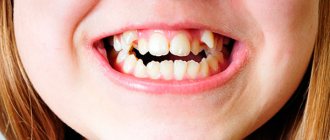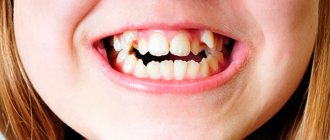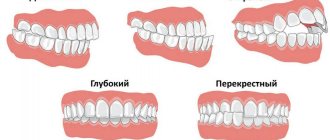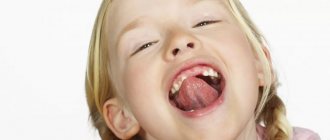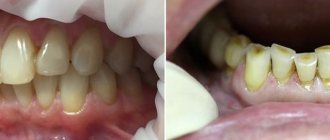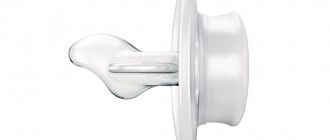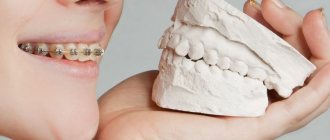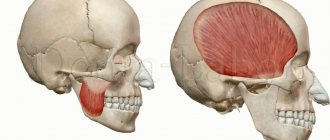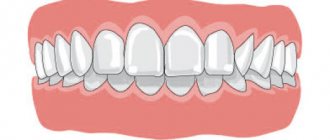23708
The formation of a person’s bite occurs in childhood before the eruption of all milk teeth.
This process is influenced by many factors - heredity, breathing problems, the position of the child during sleep.
According to most orthodontists, the use of a pacifier has the greatest impact on the development of the baby’s lower jaw and the correct growth of dental elements.
Not only the correct placement of the teeth in the jaw row, but also the further proportions of the face depend on the type and duration of its use.
Optimal age for use
Starting from the first days after birth, the baby begins to develop a sucking reflex. Innate instinct is vital for the further development of the child, as it ensures the receipt of milk from the mother's breast or bottle.
Another key purpose of the sucking reflex is to reduce motor activity of the brain and reduce the number of negative emotions.
Regular suckling of the mother's breast can reduce the baby's anxiety, promote his relaxation, and also reduce the risk of developing neurotic reactions in adulthood.
The intensity of the sucking reflex is different for each child, so in order to avoid disrupting the established diet, women often resort to using a pacifier.
The sucking instinct remains most pronounced in the first year of life. It is during this period that it performs a protective function in the baby’s body.
Using a pacifier at this stage of development allows you to achieve the following:
- distract the child from pain and discomfort;
- improve sleep;
- reduce excitability;
- eliminate the risk of tongue retraction during sleep;
- improve the bite of bottle-fed children with the correct selection of pacifiers.
Starting from 8-9 months of a baby’s life, his innate reflex gradually fades away, completely disappearing by 3-4 years.
This is due to the development of the child and the gradual transition to spoon feeding, which serves as an impetus for the development of the chewing instinct.
Therefore, most dentists and pediatricians recommend stopping further use of a pacifier during this period.
According to research, the process will bring a minimum of physiological and psychological inconvenience.
Reasons for the development of a crooked jaw and how to correct the defect.
Read here about the indications for compactosteotomy and the technique for performing it.
At this address https://orto-info.ru/zubocheliustnye-anomalii/zubov/polozheniya/etiologiya-razvitiya-i-metodyi-korrektsii-protruzii.html we will tell you what dental protrusion is and what causes it.
General harm from pacifiers
When parents think about whether the pacifier spoils the child’s bite, it turns out that there are some other negative aspects that this item can bring. Sucking on a pacifier for a long time can cause:
- Refusal to suck milk from the breast;
- Incorrect latching of the nipple during sucking, which can lead to breastfeeding pain for the mother.
- Speech delay, incorrect pronunciation of sounds and words.
- Allergic reaction.
- Delayed mental development of the child.
- Oral diseases.
- Mechanical damage in the mouth and chin area.
However, most pediatricians are of the opinion that using a pacifier for up to six months should not cause serious harm to the baby. After 6 months, the use of a pacifier is undesirable, and after a year it is necessary to reduce this habit in the child.
Negative action
Despite the benefits of using a pacifier to satisfy a baby's sucking reflex, most dentists are unanimous in the opinion that long-term use of it has a negative impact on the condition of the oral cavity.
The size of the lower jaw of a newborn is significantly smaller compared to the upper. To enhance its growth, experts recommend focusing on breastfeeding, during which the lower jaw moves forward and the tongue makes wave-like movements.
When using a pacifier, the natural muscular balance is disrupted, resulting from the pressure of the tongue on the jaw line and the contraction of the muscles of the cheeks and lips during sucking.
The nipple puts pressure on the periodontium, leading to excessive stress on the mucous membrane. As a result, emerging teeth may shift into incorrect positions.
Most often, children who abuse a pacifier are subsequently diagnosed with a distal or open bite, as well as excessive forward inclination of the teeth of the upper jaw.
Pathological changes in the structure of the dentition occur if the total duration of pacifier use exceeds 6 hours a day.
If a child uses a soothing object extremely rarely, it will not cause malocclusion.
At what age does a child develop a bite?
Parents rarely think about when a child’s bite begins to form, yet this process occurs from birth and consists of several stages:
- From birth to six months. At this time, the jaws are preparing for the appearance of the first teeth and the correct placement of them during this period is very important.
- From six months to three years - the appearance of a temporary bite.
- From three to six years - preparation of the jaw for the appearance of permanent teeth, the temporary bite is fully formed.
- From six to twelve years, the baby teeth are replaced by permanent teeth, and during this period a mixed bite is formed.
- From twelve to fifteen years, a permanent bite is formed.
As you can see, it is very important to monitor the formation of a correct bite in a child from birth, and not from the appearance of permanent teeth, as many parents believe. Already at the stage of eruption of the first milk teeth, it is necessary to ensure that there is no constant pressure on the jaw, be it a finger in the mouth, a toy or a pacifier. After all, it is for this reason that a child develops an incorrect bite, including the pacifier.
What malocclusion pathologies may appear as a result of pacifier pressure on the jaw:
- Deep (the lower jaw extends far beyond the upper).
- Open (teeth from both jaws do not close together, forming a gap).
- Mesial (the lower jaw protrudes noticeably forward).
- Distal bite (with the jaws closed, the upper jaw moves forward in relation to the lower jaw).
- Crossed (weak development of one of the sides of the upper or lower jaw is observed).
In any case, the sooner the bite is determined, the easier it will be to correct the pathology in the future. If there are obvious problems already at primary school age, it is necessary to use special structures to correct the bite, such as plates, trainers, and at an older age - a brace system.
The optimal period for correcting the bite is adolescence, when the replacement of baby teeth with permanent ones has already occurred.
Additional product disadvantages
In addition to the development of an abnormal bite, frequent use of a pacifier, according to experts, can lead to the following problems:
- Deterioration of lactation. It may take a woman from two to eight weeks to fully establish breastfeeding.
You should stop using a pacifier during this period. In addition, experts note that when using a pacifier, the baby’s sucking reflex is satisfied without applying to the breast, which leads to a decrease in the woman’s milk supply and a switch to artificial feeding. - Impaired diction. Incorrect bite and tongue position in the oral cavity, resulting from frequent use of a pacifier, lead to problems with the pronunciation of many sounds when the baby begins to talk.
- Ear infections. As a result of sucking during nasal congestion, pressure increases in the area of the auditory tube. This often leads to infection and the development of otitis media and other ear diseases.
- Low sterility. If the pacifier falls out of the baby's mouth, it must be carefully handled to avoid the development of various intestinal infections. During the period when the child begins to roll over and crawl on his own, it is problematic to monitor this.
- The emergence of a habit. With prolonged use of a pacifier, a child develops dependence. Therefore, the older the baby, the more difficult it is for him to give up the habit.
Probably, the finger is, after all, more dangerous for children's health than the pacifier.
This is explained by the fact that the finger, larger than the tip of the pacifier, affects the territory of the oral cavity. It is also believed that it is much more difficult to wean a baby from thumb sucking - after all, it is always “at hand”, the finger cannot be taken away and hidden. The use of the pacifier can be more or less controlled - “lose”, “give to the neighbor’s puppy”.
First of all, weaning off any bad habit should under no circumstances be traumatic, either physically or psychologically. Grandmother's methods of spreading mustard or brilliant green on your finger are not recommended. Abruptly taking away the pacifier is also not justified. It is better to use unobtrusive persuasion, a game form. If necessary, consult your doctor.
Selection rules
To reduce the harm caused to the baby by regular use of a pacifier, it is necessary to choose this device correctly.
Preference should be given to special orthodontic nipples. These products differ from ordinary pacifiers in their anatomical shape, which is equipped with a beveled surface on one side and a convex surface on the other.
In this case, the beveled part of the product must be placed on the side of the child’s tongue, and the convex part in the area of the palate.
Thanks to this design of the pacifier, the growth of the lower jaw is activated, which from the birth of the child significantly lags behind the upper jaw in size.
In addition, the pressure exerted on the palate and upper jaw is insignificant, which contributes to their full development.
When choosing, you must also pay attention to the following points:
- Material of manufacture. There are two types of nipples on sale: silicone and latex. Silicone products are more durable and can withstand high temperatures, making them easier to boil.
At the same time, they have little elasticity, so after teething, there is a possibility that the child will chew them.Pacifiers made from latex are more durable, however, they cannot withstand high temperatures and also quickly accumulate bacteria on the surface, so they will have to be changed more often. In addition, latex products can cause an allergic reaction.
- Size. Depending on the age of the child, the size of the pacifier changes. So, for babies up to 6 months, a size 1 pacifier is suitable. Children older than six months should use size 2.
- The presence of an air valve. This indicator is important when choosing a bottle nipple for feeding. The presence of a valve reduces the likelihood of the baby swallowing air, as well as the pacifier sticking together.
Methods of treating crowded teeth and the consequences of lack of therapy.
In this article we will discuss the problem of a small lower jaw in an adult.
Follow the link https://orto-info.ru/zubocheliustnye-anomalii/ryadov/zuboalveolyarnogo-ukorocheniya.html to learn more about dentoalveolar shortening in the molar area.
How to choose the right pacifier?
Modern parents are now seeing a huge range of pacifiers, from classic rubber ones to innovative latex ones with orthodontic properties. Which dummy will be correct and less harmful? Let's try to understand these subtle points and consider how nipples differ from each other:
- According to the material from which they are made. It is best if the nipple is made of silicone or latex. Silicone is more stable, withstands mechanical stress, but at the same time it deforms the baby’s jaws more strongly, unlike latex.
- To size. For each age of the child, a certain size of pacifier is provided; usually the manufacturer indicates this information on the packaging; compliance with this condition allows minimizing the harmful effects of the pacifier on the baby’s bite.
- According to the form. Nipples are classic and anatomical (orthodontic). Of course, experts recommend using the latter; they have less of a negative impact on the formation of the jaw apparatus.
- On the basis. It is better to choose pacifiers that have a recess on the base for the nose and chin, so they will not be damaged during active sucking.
How to wean off painlessly
The process of weaning a child off a pacifier is very individual. Some children do not notice the disappearance of the rubber device from their lives, being distracted by new activities. Others, on the contrary, experience severe stress.
Many mothers, based on their own experience, note that the process is most comfortable when the baby is between 6 and 10 months old.
To make the process as comfortable as possible, you must adhere to the following recommendations:
- choose a teether when the child’s first tooth grows - this will help distract attention from the usual pacifier and speed up the teething process;
- stop using a pacifier to soothe the child - pick him up, talk to him, rock him to sleep;
- reduce the frequency of use when getting ready for bed, replacing it with a relaxing massage, reading a fairy tale, singing a lullaby;
- Remove the pacifier from the baby's mouth after he falls asleep.
If it is necessary to wean a child older than one year from a pacifier, experienced parents advise resorting to some tricks.
For example, exchange a pacifier for an interesting toy, lose it, or offer to give it to a younger friend.
The complexity of the process of weaning a child from a pacifier may depend not only on the degree of dependence of the child, but also on his physical and emotional state at a certain point in time.
Therefore, if the baby is sick or in other stressful situations, it is better to postpone giving up the pacifier to a more favorable moment.
Orthodontic replacements
At the stage of weaning off a pacifier, a child often develops a new harmful habit - thumb sucking, and this can aggravate all existing malocclusions and cause new ones.
Orthodontists have developed several devices that can ease this period, allowing the dental arches to take the correct shape:
- Hinz records. Used from the age of 1.5 years. They can be equipped with a bite block, tongue guard or bead. Helps place the tongue in a normal position.
- STOPPI prophylactic plate. It is a vestibular silicone plate that can be used even at an early age. Due to the presence of lateral biting areas, it prevents excessive compression on the upper teeth in the frontal area. The first tendencies towards the formation of an open bite when using this plate, as a rule, disappear on their own.
- LM activator. It helps ensure that after saying goodbye to the pacifier, other bad habits do not arise, and at the same time, the normalization of the dental arches occurs.
Other influencing factors
Some parents are perplexed why, if they rarely use a pacifier or completely abandon it, the child’s bite is not formed correctly enough.
It is worth understanding that in addition to the nipple, this process is influenced by many other factors:
- incorrect head position during sleep;
- timing of teething;
- mouth breathing;
- genetic predisposition;
- posture.
To avoid the formation of malocclusion, the child’s oral cavity should be examined regularly by a dentist.
Therefore, consultation should be sought every 3-4 months from the eruption of eight baby teeth.
After the development of the primary occlusion is complete, at 2-3 years of age, visits to the dentist should occur once every six months.
In the video, Dr. Komarovsky talks about how the pacifier affects a child’s bite.
Myths and truths about baby pacifiers
On the question of whether to give a child a pacifier or not, parents and experts have long been divided into two camps. Some believe that a pacifier is a mother’s best helper, while others attribute to it harmful properties, from the formation of an incorrect bite to the influence on the child’s character. We decided to collect the most common myths about the pacifier and ask in detail pediatrician Yaroslava Matveeva, pediatric dentist Yulia Selyutina and child psychologist Natalya Gorodulina in order to understand once and for all what is truth and what is fiction.
Yaroslava Matveeva (@doctor_yaroslava)
Pediatrician
The sucking reflex is perhaps the most important reflex of a newborn baby. It is formed in the very first seconds of life and helps the baby eat. Of course, there are situations when the sucking reflex is absent - most often, this occurs in children with severe damage to the central nervous system, in premature or weakened babies. Therefore, whether to give a pacifier or not is a controversial issue, and in each family it is decided individually.
There are children with a pronounced sucking reflex - if they suck on their mother’s breast every time to satisfy it, they will simply overeat. And due to the immaturity of the stomach, such children begin to regurgitate profusely - then, of course, a pacifier will only be for the good. If a child is eating well and gaining weight, but often cries and is worried for some reason, a pacifier can also help. This also includes cases when the mother releases milk very easily - the baby manages to eat, but does not have time to satisfy the need for sucking.
But if we are talking about children who are not gaining weight well, spit up profusely, and the mother’s lactation is poorly established, then it is impossible to replace the breast with a pacifier, otherwise we will simply provoke artificial feeding.
Is a pacifier a source of infection?
It’s not very often that a pacifier can cause an infection, but such cases do happen. For example, if a child has damage to the oral mucosa, then the opportunistic microflora that is in the air and on objects can cause stomatitis. There are also situations when a mother, a carrier of some virus or bacteria, licks a pacifier and then gives it to the child. And when he grows up, this happens with the spoon. This is also a predisposing factor for the occurrence of diseases.
If one of your relatives has intestinal diseases, then you need to be very strict about hygiene - wash your hands often and do not touch objects that the child can use, in particular the pacifier. Only a healthy person should care for the child.
Does a pacifier dull pain?
Yes, it's true - sucking a pacifier or pacifier can dull pain in children from the first months of life. Children from three weeks to three months suffer from colic, and peristalsis occurs precisely during sucking - due to this, milk moves through the esophagus into the stomach, and then through the lower parts of the digestive tract. In this case, the pacifier will help the baby get rid of gas and prevent colic. But in addition to this, you need to use other methods - place the baby on his stomach 10 minutes before feeding and massage with pressure movements.
In all other cases, we cannot use the pacifier as a pain reliever - the sucking reflex will not help dull the acute pain. This is rather a distraction, but you need to understand that if something is seriously bothering the child, covering his mouth with a pacifier is wrong.
Does a pacifier prevent your tongue from sticking in your sleep?
Adults have a disease - rhonopathy or snoring. It also happens in children with lesions of the central nervous system - while falling asleep, the muscles of the soft palate relax, it begins to hang over and block the upper respiratory tract. In this case, the tongue may retract and breathing may stop during sleep. Can a person suffocate this way? It’s unlikely, because during breathing disorders, nerves are activated and the brain centers are irritated by carbon dioxide, and the person either goes into a state of superficial sleep or wakes up.
In children, this condition occurs only in cases where the nervous system has not formed. Then, of course, the pacifier will be the restraining factor that will prevent the tongue from sinking. But this will in no way save the baby from drooping and overhanging of the soft palate, so such children should be observed by neurologists. We cannot say that a pacifier is their only salvation from sleep apnea.
This condition can also occur in children with an overly large tongue - for example, when there is a pathology of the thyroid gland. In this case, the pacifier will also help prevent tongue retraction.
Shouldn't a pacifier be given while breastfeeding?
It's possible, but not necessary. If breastfeeding has become established (and this happens in the first month of a child’s life), and the mother has enough milk, the child latch onto the breast well and is gaining weight (the gain in the first month of life is at least 800 g), then the pacifier can only be used as a calming factor . But we must understand that a child over two weeks of age sometimes cries and, as it seems to us, asks for the breast, not because he is hungry, but because he just wants to see his mother. It is important for him to be in her arms at this moment, but at the same time he smells the milk, and a natural reflex is triggered. If we understand that the child is full at this moment, we can offer him a pacifier. This way he will satisfy the sucking reflex and at the same time be close to his mother.
There is an interesting fact - those who have ever breastfed and who were helped by relatives or friends in caring for the child noticed that when the mother takes the child in her arms, but does not give either the breast or the pacifier, the child cries and worries. And if at the same moment another person takes the child in his arms, he calms down. The thing is that the baby simply stops smelling his mother’s milk. This is a very common mistake of all mothers - switching to artificial feeding due to the fact that the baby often cries while breastfeeding. Mom thinks: “Now the child is eating enough.” But that’s not why he cried, but because he smelled milk (we wrote about myths about breastfeeding here).
Does a pacifier cause problems with breastfeeding?
Breastfeeding mothers may have problems - but they have nothing to do with the pacifier. The first problem is stagnation, which occurs due to the fact that more milk is produced than the baby consumes. The mechanism of milk flow is fully formed only by the age of three months of a child’s life.
Milk stagnation can occur when the baby does not latch onto the breast correctly - in this case, the baby will not gain weight. There is another problem that occurs more often in the first weeks of a child’s life - the formation of cracks in the nipples due to improper latching of the breast. This happens both in first-time mothers and in those who give birth at long intervals. When the nipple is not ready for feeding, it loses its elasticity and the baby's strong sucking movement leads to cracks.
Yulia Selyutina (@stomatolog_selyutina)
Pediatric dentist
In some cases, a pacifier is necessary. However, it is important for parents to know and remember that from a certain age, sucking a pacifier is equated to bad habits, so it is better to make an effort and wean the child in a timely manner. Otherwise, this habit can cause the formation of a malocclusion, and correcting it is a rather lengthy, labor-intensive and expensive pleasure.
Does prolonged pacifier sucking cause malocclusion?
If a child under two years of age has not gotten rid of the habit of sucking a pacifier, this can actually cause the formation of a malocclusion. Moreover, this applies not only to pacifiers, but also to the nipple on a baby bottle.
With prolonged pacifier sucking (longer than two years), there is a high risk of developing an open or distal bite. In the first case, only the chewing teeth close, and there is no contact between the central teeth. It seems that the mouth does not close completely. And with a distal bite, the lower jaw at rest seems to be pushed back, and the central teeth of the upper jaw visually “stick out” forward. A gap is formed between the upper and lower incisors - often it is so large that a finger can fit in it.
Is malocclusion caused by poor-quality pacifiers?
It is important to understand that malocclusion is formed not because of the shape of the pacifier or the material from which it is made, but because of the duration of its use. No matter how modern and anatomical a pacifier is, using it for more than two years can lead to dental and maxillary deformities.
Do special orthodontic devices help wean a child off a pacifier?
If you have difficulty weaning off the pacifier, you should consult an orthodontist who will help you find the right solution. Most often, in such cases, regular wearing of a special Stoppi vestibular plate from the Muppi brand is prescribed, which helps replace a pacifier if you have such a habit.
The plate is made from soft hypoallergenic silicone and has special side biting areas in the form of durable silicone bridges, thanks to which the plate fits comfortably in the mouth and effectively prevents compression of the upper row of teeth when sucked. If a child already has an open bite, with regular use of a preventive plate there is every chance that it will close naturally, since nothing prevents the child’s incisors from closing. But we must take into account that the Stoppi plate is recommended for children from two years of age - usually a few weeks are enough for the baby to forget about the pacifier. And to care for the record, just rinse it with warm boiled water after each use and never boil it.
Can speech therapy problems arise due to the habit of sucking a pacifier?
It’s true – deformation of the position of the teeth can cause speech therapy problems. Most often, difficulties arise with the production of already difficult for many hissing and whistling sounds - for example, “s” or “sh”.
Is a pacifier a substitute for breastfeeding?
When sucking on mother's breast, the baby makes much more effort to eat than when sucking formula from a bottle with a nipple. This is good for training the chewing muscles, which is important for the prevention of certain dentofacial anomalies. However, even prolonged breastfeeding (over two years) can become an aggravating factor and affect the formation of malocclusion.
Natalia Gorodulina (@gorodulina_psy)
Child psychologist, play therapist
When it comes to the question of whether to give a child a pacifier or not, I always advocate comfort for mother and child. You need to be guided by the situation and needs - there are children who categorically do not take a pacifier, and this is normal. And there are those who really need a pacifier - and this is also considered the norm. A tired, anxious mother who does not have the strength to smile at her baby is what is really harmful for the child. Therefore, the main advice to mothers of babies is to worry less. Trust yourself and your intuition more and, if possible, avoid sleep deprivation.
Is a pacifier addictive to a child?
The sucking reflex is a mechanism with which a child is born and which is necessary for survival, because it is thanks to it that the baby eats from the first days. If we are talking about babies under two years old, then it’s not a matter of addiction - it’s just a way to satisfy the sucking reflex.
Does a pacifier reduce your baby's activity?
It is a myth. A child, captivated by a pacifier, is busy with something important to him - satisfying the sucking reflex. This is an important stage in development, and problems can arise precisely if this reflex is not properly satisfied.
Of course, the ideal option for a baby is the mother's breast, but breastfeeding is not always possible, so a pacifier is a normal alternative option. The sucking reflex subsides around 12 months, and some children themselves refuse the pacifier by this time. If not, then the appropriate age for weaning a baby off a pacifier is one and a half or two years (we wrote more about how to wean a child off a pacifier here).
Do children accustomed to a pacifier or pacifier grow up less sociable?
Quite the contrary - children with a certain type of nervous system (impressive, sensitive, excitable or introverted) most often need a pacifier to calm them down. They grow up quiet and introverted, not because of the habit of sucking a pacifier, but because that is their temperament.
This also includes the myth that children who are accustomed to a pacifier move away from their mother with age. The emotional connection between a child and his mother is formed from birth and does not depend on the presence or absence of a pacifier.
Can an addiction to pacifiers develop into bad habits?
There are psychological researchers who claim that smoking is a consequence of an unsatisfied sucking reflex. So the connection with the dummy here is rather the opposite. As for the habit of biting nails, it, again, occurs in people with a weak type of nervous system who do not tolerate any stress and tension well. This is just their way of calming down and has nothing to do with the pacifier.
Does a pacifier calm your baby?
But this is true.
As I said earlier, a pacifier helps satisfy the sucking reflex. Just as we feel good when we satisfy our hunger, our baby feels calm when he sucks on a pacifier. If, with the help of a pacifier, a child falls asleep faster and sleeps more soundly at night, the mother should definitely use it. Sound sleep is the most important condition for health for both mother and baby. Text: Anastasia Speranskaya
